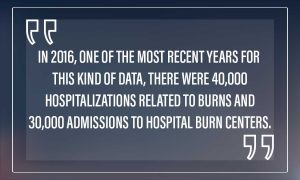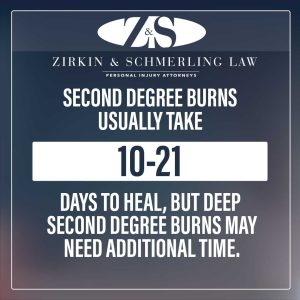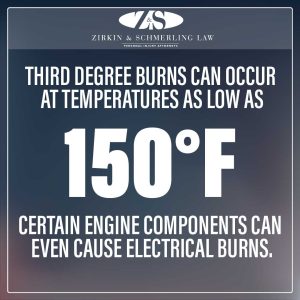
Motorcycle accidents can result in some of the most severe and even life-threatening injuries. This can include broken bones, spinal cord injuries, head and brain injuries, and amputations. However, burned skin and other burn injuries are also common with motorcycle accidents–and they can be both severe and deadly.
The American Burn Association released a fact sheet that details the seriousness of severe burns in the US. Specifically, in 2016, one of the most recent years for this kind of data, there were 40,000 hospitalizations related to burns and 30,000 admissions to hospital burn centers.

These hospital admissions with care from a burn team included burned skin from electrical burns, hot liquids, fires, accidents, and more. Superficial burns may not require medical treatment, but more serious burns will usually require medical treatment. . Motorcycle riders are especially vulnerable to burn injuries in the event of an accident due to lack of protection from a vehicle body. Burns can damage soft tissues and often a burn affects even a major joint, causing severe health risks. Most burns include symptoms of redness, blisters, a white/charred layer of skin, and intense pain. A burn evaluation for severity from a burn team helps determine treatment.
If you are injured in a Maryland motorcycle accident, don’t hesitate to reach out for legal assistance. Paying for medical treatment for a burn injury can be expensive, but a personal injury attorney can help. They can help you file a motorycycle accident claim and ensure you get the full compensation you deserve to help you pay for your burn injury and other damages and prove how the burn affects your life.
Why Are Burns So Common in Motorcycle Accidents?
Severe burn injuries are commonplace after motorcycle accidents because of how many risk factors there are. Some of the things that make it easy for motorcycle accident victims to have serious burns include:
- Exposure: Motorcyclists lack the enclosed metal structure of a car to shield their bodies in the event of a crash. This leaves the skin and extremities exposed and vulnerable to burn wounds.
- Friction: When motorcyclists slide along the pavement in an accident, it can cause severe friction burns called road rash. The friction from sliding against the road at high speeds can severely burn the skin and leave burn scars.
- Hot motorcycle parts: Coming into contact with hot exhaust pipes or the exposed engine block after a crash can cause serious contact burns. These parts can reach temperatures over 500°F. Certain engine components can even cause electrical burns.
- Flammable materials: Gasoline and oil are flammable. They can ignite in the heat of an accident, causing dangerous flames that engulf riders and cause direct flame burns. Exposure to this kind of fire can cause full thickness burns.
- Melting materials: Some motorcycle clothing and parts are synthetic and can melt onto skin when heated, causing chemical burns.
- No protection of the limbs: Many riders only wear helmets and jackets, leaving their arms and legs exposed. This leads to the top layer of skin being burned off and an increased susceptibility to deeper, more serious burns, including third degree burns.
Common Types of Motorcycle Accident Burn Injuries
As you can see from the section above, it is clear why burns are common in motorcycle accidents. However, because there are different kinds of burns, the treatment of one person’s burn injury may be different from the treatment of someone else’s. Each burn affects burn patients and even the burned area differently.
For example, chemical and electrical burns may need different treatments, as do thermal burns, contact burns, and serious burns from flames. First degree burns can be caused by touching any hot surface; second degree burns (called partial thickness burns) and third degree burns (full thickness burns) can result from any of the following types of burn injury.
First degree burns affect only the outer layer of skin while second degree burns reach deeper into layers. Most motorcycle burns are third degree burns extending through every layer of skin, causing extensive tissue damage. Fourth degree burns reach bone, exposing critical organs to infection risk. Memory loss, organ failure, and death can occur from major burns. Burned areas require cleaning with mild soap to prevent infection and are covered in medicated dressings to reduce pain and promote wound healing of damaged or dead tissue.
Let’s take a look at the types of burns that the above risk factors can cause.
Thermal Burns
Severe motorcycle accidents can result in fires or explosions. When this happens, it can lead to thermal burns that can seriously damage the skin. Thermal burns include damage from anything that is incredibly hot, including steam, scalding water, fire, etc. A severe burn from a thermal injury requires medical treatment to protect the affected layer of skin right away.
Chemical Burns
Motorcycles can leak toxic and corrosive chemicals, such as battery acid and gasoline, when damaged in an accident. If the skin of the rider comes into contact with these substances, it can result in chemical burns. A severe burn from chemical exposure can lead to a long period of recovery, especially if you don’t receive immediate treatment for your burn injury.
Engine and Exhaust Pipe Burns
The metal components on a motorcycle can get extremely hot, such as the engine and the exhaust pipe. After an accident, riders can get trapped against these hot surfaces, which can lead to severe burns.
Friction Burns
Road rash is a type of friction burn that occurs when the skin is dragged or skids along a rough surface, such as asphalt. It’s very common after motorcycle accidents for riders to sustain these types of friction burns as they don’t have much to protect their bodies.
Burn Injury Complications After a Motorcycle Accident
First and second degree burns from motorcycle accidents—while still quite painful—often heal with minimal treatment. However, more severe burns, such as third degree burns or third degree road rash, are harder to treat and can lead to complications.
Burn survivors must be highly attentive to the healing process. As your burn heals, watch for burn symptoms that may change over time. For example, burn blisters from superficial burns could become infected, so it is important to watch even minor burns for the following signs.
If you notice any of the signs or symptoms below, you should seek emergency medical care to have your burn injury treated as soon as possible:
- Pain that continues to worsen
- Fever
- Chills, nausea, and body aches
- Swelling in a major joint
- Redness that continues to get worse
- Pus or fluid drainage
- Skin discoloration around the wound
- A foul smell emanating from the wound
- Heat radiating from the wound
Partial thickness burns are usually treated in the Emergency Department, but full thickness burns will likely land burn patients in the hospital for an extended stay. In that case, you will have medical professionals evaluating you for these things as well. If you are in a burn center, you can expect to receive treatment for your injuries by the best burn injury specialists in your area.
A hospital burn center can perform skin grafts on the layer of skin, help burn patients with both physical and occupational therapy needs, treat the lungs for any inhalation injury that has been suffered after smoke inhalation, and provide exceptional burn care. A burn center will treat patients who have burns over their total body surface area or other traumatic injuries.
For burn patients who end up staying in a burn center, the cost can be significant. Be sure to seek guidance from a highly qualified burn injury attorney to find out how to get compensation for these costs.
Motorcycle Accident Burn Injury Treatment
Nearly 300,000 people died from fires or burn injuries worldwide in 2016 based on the Global Burn Registry. Most burns are preventable yet over 1,000 deaths from burn injuries were reported in the U.S. that year. Proper motorcycle gear can prevent burns but any burn patient suffering traumatic injury from an accident needs immediate medical care and evaluation by a specialized burn trauma team to treat the wound, manage pain, and begin rehabilitation procedures for severe skin damage, scarring, or disability.
Medical professionals will decide the best course of action for your burn treatment, depending on burn severity. First degree burns are likely to be treated at the scene of the accident, at the hospital, or even at home following the crash. Second degree burns are a bit more severe, and you may not be able to treat the burned areas at home. A third degree burn is the most severe and requires extensive medical attention, likely including hospitalization.
Let’s learn more about first degree burns, second degree burns, third degree burns and what to expect from each one.
First Degree Burns
First degree burns affect only the outer layer of skin (only the epidermis). These minor burns require cleaning the wound with mild soap and water to remove debris and prevent infection. It is very likely that you can take care of a first degree burn at home.
After cleaning the burned area, an antibiotic ointment can then be applied and the area wrapped in sterile gauze or a loose bandage that allows air circulation. Over-the-counter pain medication like ibuprofen helps relieve discomfort as first degree burns heal. Watch for signs of infection including increasing redness, swelling, oozing, and fever.
First degree burns generally heal within 5-10 days with proper care. They are sometimes referred to as superficial burns, as only the epidermis is affected.
Second Degree Burns

Second degree burns go deeper into the skin layers, causing pain, redness, blistering, and swelling. It is crucial to gently wash the burned area with mild soap and water, apply antibiotic ointment on the burn patient, and cover the burned skin with a sterile non-stick bandage that allows air flow.
The bandages on the burned area will need frequent changing to keep the wound clean. Over-the-counter pain and anti-inflammatory medication can help manage pain. Watch closely for infection which requires prescription oral antibiotics.
Second degree burns usually take 10-21 days to heal, but deep second degree burns may need additional time. To get back to healthy skin after second degree burns, avoid popping blisters to prevent infection of the burned area. Seek additional medical care if the wound does not begin to heal within a few days.
Note that second degree burns are often called partial thickness burns.
Third Degree Burns

Third degree burns are one of the most severe burns you can experience. They destroy all layers of skin and underlying tissues, and they always require emergency medical treatment, ideally from a wound care specialist. Burn care treatment for this degree burn starts with assessing the size and depth of the burn to determine the need for IV fluids, pain control, surgical debridement, and skin graft treatment.
After a third degree burn, the damaged tissue must be removed and the wound meticulously cleaned and disinfected to prevent life-threatening infection and sepsis. A skin graft or flap may be required for large areas of damaged or burned skin. With proper emergency care and vigilance against complications like infections, third degree burns can heal in several weeks to months depending on severity.
Note: third degree burns are also called full thickness burns. They can cover one area of the body or the total body surface area.
Fourth Degree Burns
Fourth degree burns extend beyond the skin and underlying fat and tissues to damage muscle, tendons and even bones. They most commonly result from electrical burns but can also be caused by prolonged exposure to heat or chemicals. These severe burns require immediate emergency medical care to prevent permanent injury or death.
The treatment for for a fourth degree burn starts with assessing the depth and extent of tissue damage. From there, your medical team will determine the need for IV fluids, pain control medications, surgical debridement and reconstructive surgery.
Damaged muscle and tendons may need surgical repair. The outer layer of tissue must be removed and the wound thoroughly cleaned and disinfected to avoid sepsis. Amputation of burnt extremities may be necessary if muscle and skin damage is too severe.
You will likely need skin grafts, multiple surgeries, physical therapy, and a lengthy recovery process for this degree burn. With aggressive emergency burn care treatment, vigilant wound care, and months of rehabilitation, it is possible to regain function after fourth degree burns, but permanent burn scars, skin damage, and impairment are likely.
Preventing Complications
First degree burns may have only a small impact on your life, but severe burns, especially second and third degree burns, remain at high risk for complications like wound infections, sepsis, and hypothermia even after initial burn care treatment.
Signs of complications include:
- Increasing pain
- Elevated blood pressure
- Odor
- Heat
- Redness
- Swelling
- Oozing around the wound
- Fever
- Symptoms of hypothermia
Any of these signs require immediate medical attention to prevent life-threatening complications. Stay alert to problems that occur during the healing process, regardless of the degree burn you suffered. Also be aware of complications from other effects of the accident, such as an inhalation injury.
How Proper Gear Can Protect You from Severe Burn Complications
When riding a motorcycle, wearing the proper protective gear is vital to prevent major burn injuries in the case of an accident. Extensive, severe burns can damage soft tissues down to major joints and bones. Without the barrier of a car chassis, motorcycle riders are vulnerable to contact with hot engine parts, scrapes along asphalt, or hot liquids leaked on roadways.
Proper motorcycle jackets, pants, boots, and gloves act as a shield against direct contact burns. These items are made of leather or specialized materials that resist heat and abrasion on impact. Helmets also protect motorcycle riders’ heads and faces from traumatic collisions. Having the right gear greatly reduces risks of first, second, or dangerous third degree burns that damage all layers of skin and tissue.
As mentioned above, over 1,000 burn injury deaths still occur annually in the U.S. based on American Burn Association estimates. However, most burns are preventable with proper precautions. For motorcyclists, defensive riding techniques combined with helmet use and protective clothing protect each layer of skin and provide burn prevention. However, any burn patients suffering minor burns, major burns, or tissue damage require immediate medical care, burn center treatment, and occupational therapy to survive and rehabilitate from the traumatic incident.
Getting Compensation For Your Burn Injuries After a Motorcycle Accident
Burn injuries incurred in a motorcycle accident often lead to extensive medical burn care treatment, lost wages from missing work, and lasting disabilities. As the victim, you may be entitled to compensation for these damages. Filing a personal injury lawsuit is one of the most effective ways to ensure that you are fairly compensated for a burn injury caused by someone else’s negligence or recklessness.
Here are some things to do that will increase your chances of winning a claim for a burn injury, including severe burns, partial thickness burns, and full thickness burns.
Document Your Injuries
Be sure to take photographs of any burn injury throughout the burn care treatment and healing process. Keep all medical records, treatment notes, including those from occupational therapy, and receipts for medications to relieve pain, equipment rentals, etc.
For severe burns, including second degree burns and third degree burns, there will certainly be major bills adding up. Physical and occupational therapy, skin grafts, and medical care for this traumatic injury comes at great cost.
You will also want to document any loss of income that accompanies any traumatic injury from a motorcycle accident. Pay stubs, copies of communication with your supervisors at work, and medical records will prove the financial damages that have occurred because of your burn injury.
Prove Liability
To receive compensation, you must prove the other party was negligent or liable for causing the accident.
A burn injury attorney can help investigate the circumstances and identify sources of liability such as:
- Another driver running a red light or stop sign
- Vehicle manufacturer defects like brake failure
- Poorly maintained roads that contributed to the crash
- Lack of protective barriers on roadways
Calculate Damages
Work with your burn injury attorney to calculate both economic and non-economic damages like:
- Medical burn care treatment costs, both current and ongoing
- Lost income and reduced earning capacity
- Pain and suffering
- Disability or disfigurement from third degree burns or higher
- Emotional distress of burn patients
File a Claim or Lawsuit
Your burn injury attorney can first attempt to negotiate a fair settlement with insurers. If that fails, filing a personal injury lawsuit allows you to compel compensation in court. An experienced attorney handles the complex legal process for you while you focus on recovery.
Burn injuries from motorcycle crashes can entitle victims to significant compensation. A knowledgeable burn injury attorney helps victims recover damages so they can pay medical bills and replace lost income during their healing and rehabilitation process.
Have a Legal Question About Burn Injuries and Your Motorcycle Accident Case? We Have Answers.
Burn injury treatments are not cheap, especially if you sustain more severe, third degree burns after a motorcycle accident. Ever with a minor burn or an inhalation injury, burn survivors will need to work with an attorney, so you have a better chance of getting a high-value settlement to cover your medical costs and other damages.
At Zirkin and Schmerling Law, our team of Maryland personal injury attorneys is dedicated to helping injured motorcycle accident victims get the compensation they deserve. We know what it takes to fight for our client’s rights to ensure they are protected after suffering a major burn and win the settlement they need to cover their losses and focus on their wound healing. Don’t let your worry or stress raise your blood pressure.
Contact us or call us at 410-753-4611 to set up an appointment with one of our motorcycle accident burn injury attorneys today.
